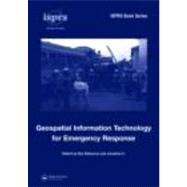
Note: Supplemental materials are not guaranteed with Rental or Used book purchases.
Purchase Benefits
What is included with this book?
| Acknowledgements | p. vii |
| Contributors | p. ix |
| Introduction | p. xi |
| About the editors | p. xv |
| Practice and legislation | |
| Improving geospatial information in disaster management through action on lessons learned from major events | p. 3 |
| Legal aspects of using space-derived geospatial information for emergency response, with particular reference to the Charter on Space and Major Disasters | p. 21 |
| Data collection and products | |
| Real-time data collection and information generation using airborne sensors | p. 43 |
| Satellite remote sensing for near-real time data collection | p. 75 |
| Terrestrial mobile mapping towards real-time geospatial data collection | p. 103 |
| Data management and routing in 3D | |
| Real time and spatiotemporal data indexing for sensor based databases | p. 123 |
| A 3D data model and topological analyses for emergency response in urban areas | p. 143 |
| Multidimensional and dynamic vehicle emergency routing algorithm based on 3D GIS | p. 169 |
| Positioning, virtual reality and Simulation | |
| 3D positioning systems for emergency response | p. 187 |
| Virtual Reality for training and collaboration in emergency management | p. 207 |
| Visual analytics in flood forecasting | p. 217 |
| Integration of heterogeneous data | |
| The semantic mismatch as limiting factor for the use of geospatial information in disaster management and emergency response | p. 243 |
| CityGML-3D city models and their potential for emergency response | p. 257 |
| Integrated emergency management: Experiences and challenges of a national geospatial information provider, Ordnance Survey | p. 275 |
| Applications and solutions | |
| The value of Gi4DM for transport and water management | p. 313 |
| A decision support system for the preventive evacuation of people in a dike-ring area | p. 329 |
| GIS technology and applications for the fire services | p. 353 |
| Author index | p. 373 |
| Subject index | p. 375 |
| ISPRS Book Series | p. 381 |
| Table of Contents provided by Ingram. All Rights Reserved. |
The New copy of this book will include any supplemental materials advertised. Please check the title of the book to determine if it should include any access cards, study guides, lab manuals, CDs, etc.
The Used, Rental and eBook copies of this book are not guaranteed to include any supplemental materials. Typically, only the book itself is included. This is true even if the title states it includes any access cards, study guides, lab manuals, CDs, etc.